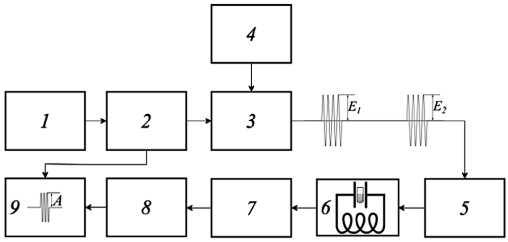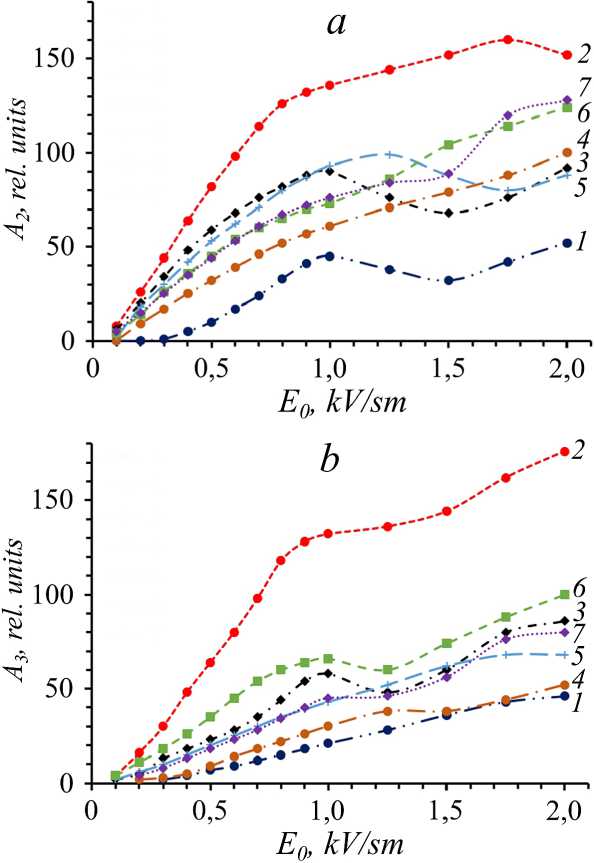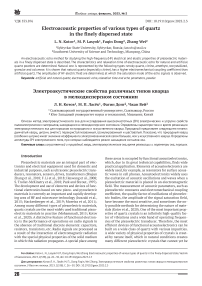Electroacoustic properties of various types of quartz in the finely dispersed state
Автор: Kotov L., Lasyok M., Dong Fagin, Wei Zhang
Журнал: Вестник геонаук @vestnik-geo
Рубрика: Научные статьи
Статья в выпуске: 2 (338), 2023 года.
Бесплатный доступ
An electroacoustic echo method for studying the high-frequency (HF) electrical and elastic properties of piezoelectric materials in a finely dispersed state is described. The characteristics and relaxation time of electroacoustic echo for natural and artificial quartz powders are determined. Natural one is represented by the following types: smoky quartz, citrine, amethyst, recrystallized, granular and columnar. It is shown that natural quartz (especially citrine), has a higher electromechanical coupling coefficient than artificial quartz. The amplitudes of HF electric field are determined, at which the saturation mode of the echo signals is observed.
Artificial and natural quartz, electroacoustic echo, relaxation time and echo parameters, powder
Короткий адрес: https://sciup.org/149142782
IDR: 149142782 | УДК: 553.876 | DOI: 10.19110/geov.2023.2.3
Текст научной статьи Electroacoustic properties of various types of quartz in the finely dispersed state
Piezoelectric materials are an integral part of electronics and electrical equipment used for domestic and industrial purposes, such as ultrasonic piezoelectric transducers, resonators, sensors, drives, transformers (Shujun Zhang et al., 2018; F. Li et al., 2018; Heywang et al., 2008; S. Trolier-McKinstry et al., 2018; Park and Shrout, 1997). The development and use of elements and devices of functional electronics based on new piezo- and pyroelectric materials is currently an important and rapidly developing area of HF and microwave technology (Iwazaki et al., 2015; Hackenberger et al., 2019; Moreira et al, 2011). Among many different types of piezoelectric materials, quartz crystals are the most widely used traditional piezoelectric materials in practice (Mohammadi, 2015; Kotov et al., 2020). A distinctive feature of functional electronics is the performance of operations on radio signals in the absence of traditional discrete elements: capacitors, resistors, transistors, etc. Radio signals are processed as a result of the interaction of electromagnetic radiation with the special physical properties of the solid medium in which this radiation propagates. A special place among these areas is occupied by functional acoustoelectronics, which, due to its great technical capabilities, finds wide practical application. Elements of acoustoelectronics are widely used, for example, as resonators for surface acoustic waves in cell phones. Acoustoelectronics widely uses the excitation of acoustic oscillations and waves when a piezoelectric material is placed in an electromagnetic field. The measurement of acoustic parameters, such as piezoelectric constants and electromechanical coupling coefficient, the quality factor of oscillations of piezoelectric bodies, the amplitude of the signal saturation field, have become the most sensitive, and sometimes the only possible methods for determining the nature of materials (Kotov et al., 2020). One of the most important properties of quartz crystals is an infinitely high-quality factor of vibrations and a wide band of operating frequencies of the piezoelectric transducer. Therefore, the most efficient devices of functional acoustoelectronics can be built on a wide class of quartz with various impurities. A wide variety of physical properties of crystals is created by nature itself, which in natural conditions creates many different piezoelectric crystals that cannot yet be
created artificially (Kotova et al., 2018; Chen Mulan et al., 2021). This article presents the results of our study of high-frequency (HF) piezoelectric properties and quality factor of electroelastic oscillations of different types of natural quartz in comparison to similar properties of artificial quartz. Here, we also consider possible mechanisms and methods for enhancing the piezoelectric properties and increasing the quality factor of electroelastic vibrations, for example, by introducing impurities when growing quartz crystals in artificial conditions.
Methodology and techniqueof the experiment
A convenient method for studying the electrical and elastic properties of piezoelectric materials can be the electroacoustic echo (EAE) method (Kajimura, 1982; Shutilov et al., 1985). The EAE method consists in the occurrence of an electrical response after excitation of an ensemble of piezoparticles (powder) by radio pulses of an electric field (Fig. 1). The EAE method allow studying

Fig. 1. Time sequence of radio pulses of the electric field E1, E2, E3 and two- and three-pulse echo signals A2, A3
Рис. 1. Временная последовательность радиоимпульсов электрического поля E1, E2, E3 и сигналов двух- и трёхим-пульсного эха A2, A3
the HF electrical and elastic properties of materials at high amplitudes of electric fields and elastic deformations that are unattainable by other methods. With its help, it is possible to study the nonlinear electrical and elastic properties, the distribution of surface charges, defects and their mobility in particles, which manifest themselves in large samples only in a weak form (Shutilov et al., 1985). For effective excitation of elastic oscillations of piezoparticles, it is necessary that the acoustic resonance condition be satisfied, under which the particle sizes should be of the order of the elastic wave length in the material under study. Two- and three-pulse electroacoustic echoes in piezoparticle powders are observed in the time intervals during which the sound is attenuated in the studied material. material. This time for solids does not exceed a fraction of a second; therefore, the available standard equipment for observing nuclear quadrupole resonance (NQR) satisfies all the requirements imposed on the duration, amplitude of radio frequency pulses, and the amplitude of weak receiving electrical signals emitted by piezoelectric powder.
In this work, studies of two- and three-pulse electroacoustic echoes in quartz powders were carried out with pulsed panoramic spectrometer ISP-1. The main blocks of the ISP-1 spectrometer are shown in Fig. 2. The ISP-1 spectrometer has the following parameters: operating frequency range f = 1÷20 MHz, radio pulse duration 0.1÷100 μs, voltage applied to the parallel oscillatory circuit 0.1÷3 kV.

Fig. 2. Block diagram of the ISP-1 spectrometer for studying two- and three-pulse electroacoustic echoes in piezoelectric powders: synchronization unit (1), time interval unit (2), radio pulse shaper-amplifier (3), sinusoidal signal generator (4), matching device (5), a measuring device in the form of an inductor with a capacitor (6), a receiver with a signal amplifier (7), an attenuator (8), an oscilloscope for observing signals (9).
Рис. 2. Блок-схема спектрометра ИСП-1 для исследования двух- и трёхимпульсного электроакустического эха в пьезоэлектрических порошках: блок синхронизации (1), блок временных интервалов (2), формирователь-усилитель радиоимпульсов (3), генератор синусоидальных сигналов (4), согласующее устройство (5), измерительное устройство в виде катушки индуктивности с конденсатором (6), приёмник с усилителем сигналов (7), аттенюатор (8), осциллограф для наблюдения сигналов (9)
As a rule, an oscillatory circuit consists of an inductor, measuring and trimmer capacitors. To study the electroacoustic echo, the substance under study is placed between the plates of the measuring capacitor. The time interval from the end of the exciting radio pulses to the moment of observation of echo signals, in which it is impossible to observe electroacoustic responses, is 10—20 μs. In this work, all studies of quartz powders were carried out at room temperature T = 300 K. In experiments on the study of electroacoustic echo in quartz, the frequency of the electric field was f = 16.5 MHz, the duration of all radio pulses of the electric field was ∆t = 4 μs. The amplitude of the electrical response of the two-pulse echo was determined depending on the voltage across the capacitor with the sample at a constant interval between the first two radio pulses τ = 30 μs and between the second and third radio pulses Tp = 1 ms. From the obtained dependence of the amplitude of the two-pulse echo on the interval between radio pulses τ, the relaxation time of the two-pulse echo T2 was determined and from this the quality factor of the electroelastic vibrations of quartz particles of the powder Q = f·T2 was found.
Sample preparation, characterization and composition
All experiments on the study of different quartz were performed on powder samples with particle sizes of 75— 125 μm. Powders with these particle sizes were obtained using a set of measuring sieves with mesh sizes of 75 and 125 μm.
The selected sizes of powder particles corresponded to half the length of the elastic half-wave in the materi- 27
Table 1. Content of impurity elements, 10-4 wt. %
Таблица 1. Содержание примесей в кварце, 10-4 мас. %
All types of quartz that were used to study the electroacoustic echo were selected in the Subpolar Urals (Russia). Along with silicon oxide, they contain various impurities to a large extent. In the Subpolar Urals (Russia), a variety of vein quartz is widely developed, which is used as a technical raw material. Table 1 shows the average content of impurities for various types of quartz, most of which were taken from the hydrothermal quartz veins of the Lyapino anticlinorium. Impurities of Al, Cu, Fe, Mg, Mn atoms were determined by the spectral method at the Institute of Geology of the Komi Scientific Center of the Ural Branch of the Russian Academy of Sciences (Syktyvkar, Russia), and impurities of Na, Ka, Li atoms were determined at St. Petersburg Mining University (St. Petersburg, Russia) (Kotova et al., 2018).
Experimental results and discussion
Figure 3 shows the amplitude dependences of two-(a) and three-pulse (b) electroacoustic echo in powders obtained from different types of quartz. It can be seen from Fig. 3 that the dependences of the two- and three-pulse echo on the electric field strength А2(Е02), А3(Е03) have linear and non-linear sections. For the linear section at the electric field amplitude E0< E02max, E03max a linear increase in the amplitude of the two- and three-pulse electroacoustic echo is observed depending on the electric field strength. The second region at E0 > E01max, E02max corresponds to the nonlinear region, in which it 28
is possible to distinguish areas of saturation and decay of the amplitudes of the echo signals. The areas of saturation of the echo amplitude can be associated with the area of saturation of the permittivity of quartz crystals. The observed segments of the decay of the amplitudes of the A2, A3 echo can be caused by the breakdown of the elastic oscillations of quartz particles at high amplitudes of the electric field (Kajimura, 1982) due to a change in the natural frequency of the elastic oscillations. The decrease in the A2 amplitude in the region of the two-pulse echo decay is the least observed for artificial quartz, which indicates small excited amplitudes of elastic oscillations of powder particles compared to the amplitude of oscil-

Fig. 3. Dependences of the amplitude of two- (a) and three-pulse (b) echo on the amplitude of the HF field for different types of quartz: artificial (1), smoky (2), citrine (3), amethyst (4), recrystallized (5), granulated (6), columnar (7)
Рис. 3. Зависимости амплитуды двух- (а) и трёхимпульс-ного (b) эха от амплитуды ВЧ поля для разных типов кварца: искусственного (1), дымчатого (2), цитрина (3), аметиста (4), перекристаллизованного (5), гранулированного (6), шестоватого (7)
Table 2. Characteristics of electroacoustic echo of powders of different types of quartz
Таблица 2. Характеристики электроакустического эха порошков разных типов кварца
Список литературы Electroacoustic properties of various types of quartz in the finely dispersed state
- Chen Mulan, Dong Faqin, Li Hailong, Zhao Yulian, Ou Shi, Liu Mingxue, Zhang Wei. Interface interaction between highsiliceous/calcareous mineral granules and model cell membranes dominated by electrostatic force. Environmental Science and Pollution Research, 2021, 28(21), pp. 27432—27445.
- Hackenberger, Bellaiche L., Xu Z., Chen L. Q., Shrout T. R. and Zhang S. J. Giant piezoelectricity of Sm-doped Pb (Mg1/3Nb2/3)O3–PbTiO3 single crystals. Science, 2019, 364, pp. 264—268.
- Heywang W., Lubitz K., Wersing W. Piezoelectricity: Evolution and Future of a Technology. NY: Springer Science & Business Media, 2008. Iwazaki Y., Yokoyama T., Nishihara T., Ueda M. Highly enhanced piezoelectric property of co-doped AlN. Appl. Phys. Express, 2015, 8. pp. 061—501.
- Kajimura K. Dynamic polarization echoes in powders materials. In: Phys. Acoust., N.Y., 1982, 16, pp. 295—340.
- Kotov L. N., Kotova E. L., Gӧmze L. N. Electroacoustic properties of quartz minerals in a finely dispersed state. Journal of Silicate Based and Composite Materials, 2020, V. 72, pp. 178—181.
- Kotova O. B., Harja M., Kotov L. N., Ponaryadov A. V. Titanium minerals as prototypes of functional materials with pronounced electromagnetic properties. Vestnik of Institute of Geology of Komi SC of UB of RAS, 2018, No. 4, pp. 34—39. (doi 10.19110/2221-1381-2018-4-34-39).
- Li F., Cabral M. J., Xu B., Cheng Z. X., Dickey E. C. at al. Recent developments in piezoelectric crystals. Journal of the Korean Ceramic Society, 2018, No. 55, pp. 419—439.
- Mohammadi M. M. A comparison between quartz and PZT ceramic for Sensoric applications. Research Desk, 2015, 2(4).
- Moreira M., Bjurström J., Katardjev I., Yantchev V. Aluminum scandium nitride thin- film bulk acoustic resonators for wide band applications. Vacuum, 2011, 86, pp. 23—26.
- Park S. E., Shrout T. R. Ultrahigh strain and piezoelectric behavior in relaxor based ferroelectric single crystals. J. Appl. Phys., 1997, 82, pp. 1804—1811.
- Shujun Zhang, Fei Li, Fapeng Yu, Xiaoning Jiang, Ho-Yong Lee, Jun Luo and Shrout T. R. Recent Developments in Piezoelectric Crystals. Review. Journal of the Korean Ceramic Society, 2018, No. 55 (5), pp.19—439.
- Shutilov V. A., Andzhikovich I. E., Komashnya V. L., Kotov L. N. Glass-like anomalies of electro-acoustic echo in crystalline quartz powders. Solid State Physics, 1985; 27 (3): 929—930.
- Trolier-McKinstry S., Zhang S., Bell A. J. and Tan X. High-Performance Piezoelectric Crystals, Ceramics, and Films. Annu. Rev. Mater. Res., 2018, No. 48(1), pp. 191—217.


